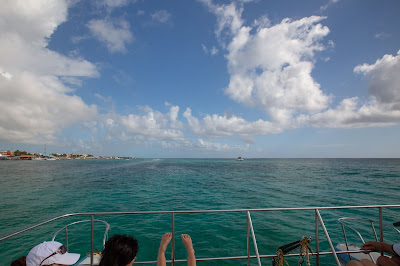Greetings from Belize Marine TREC in San Pedro, Ambergris Caye, Belize! I am writing this blog after dinner, as the students are hard at work on the first sections of their lab reports.
Today was a long and eventful day with 7+ hours spent on the water. We saw a tremendous variety of wildlife today and made great progress on formalizing our research project.
After a hearty breakfast of French toast and biscuits at 8AM, we lotioned up and headed to the beach, boarding our research vessel Goliath at around 9AM. Today's first site is the farthest northern point we will venture, about 15 miles south of the Mexican border. It took us about 1:15 to chug our way there through calm seas and blue skies dotted with white clouds:
Along the way, we held a lab meeting to discuss the students' ideas for our research project. Everyone made helpful contributions as we honed in on a unified research question:
We were greeted by a group of 3 dolphins who swam alongside and under the boat for about 10 minutes. It was a great sight and it turned out to be a portent of even better encounters to come:
We arrived at our snorkel site, called Mexico Rocks. This is a Marine Protected Area, part of the Hol Chan Marine Reserve. As such, there were many rules and guidelines that governed our activity. To start, a park ranger pulled alongside, collected fees, and issues wristbands. This helps to limit the number of park visitors allowed in each day:
We spent about two hours on a guided tour of a large set of patch reefs that were teeming with a wide variety of colorful wildlife. We saw dozens of species of coral, sponge, anemones, and fish. Below is a small sampling of what we saw:
The last photo shows a group of squid that we surrounded and watched for several minutes. The squid communicate with each other through color changes below their skin, causing them to cycle through several colors as we watched, from clear to yellow to purple to black. It was fascinating to watch!
Toward the end of our tour we came upon Belize Reef Enemy #1: the lionfish. This invasive species is designated "kill on sight" - they do so much damage to the reef populations that everyone is asked to kill them immediately. Our guide successfully speared this fairly large specimen and added it to a collecting bucket on board:
Yay for dead lionfish! From Mexico Rocks, we motored to a large underwater cave. Students were encouraged to dive down as far as they dared:
While parked at this site, we had some wonderful wildlife encounters. See the videos below!
We were all quite excited to see a dolphin so close. In fact, I'm not sure I've ever seen a group of students so excited! Everyone loves the megafauna.
We drove a few minutes to our last site of the day, a reef called Playa Blanca. Here, the students practiced their laboratory data collection, trying out their ideas to see how practical they are in the open ocean. While there, we also enjoyed the reef and its abundant marine life:
Playa Blanca was also our first up-close encounter with a nurse shark. They are quite safe and gentle, and nearly everyone had "shark encounter" on their Belize bucket list:
It's easy to become overwhelmed by the sheer number of sights to be seen on a tropical coral reef, or to be caught up in cataloging all that one can see. But every once in a while, one can't help but be struck by the sheer beauty of this ever-changing seascape:
The lab practice was helpful, and we spent our boat ride back discussing how to improve our protocol. We arrived back at the beach around 4:30PM, all a bit crisp, salty, and quite satisfied. We convened in the TREC classroom at 5:30PM for an hour long lab meeting during which the method for our lab project was finalized. As I type, students are finishing dinner and preparing to get to work on their lab reports afterward.
All is well here, although I will say that there seem to be more sunburns than usual. I'm on them, don't worry! SPF50 for everyone! Otherwise, there are no significant problems and every student is availing him or herself well and appropriately. Thank you to New England College for providing us all with this opportunity!
Thanks for reading!
- Eric J. Simon, Ph.D., Professor, Department of Biology & Health Science, New England College


















No comments:
Post a Comment